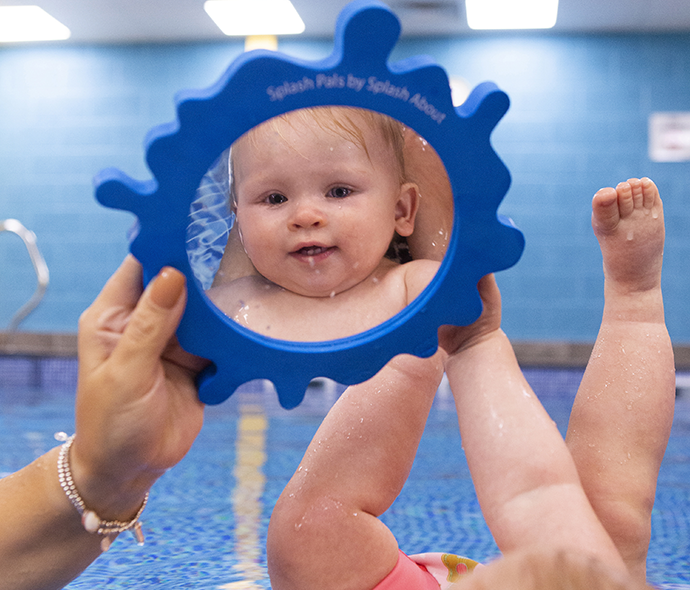Reviewed 13th March 2023
Taking your baby swimming- The Complete Parent's Guide
Planning a trip to the pool with your little one? You're not alone. Thousands of people take their babies swimming each year. The activity has soared in popularity recently and there are plenty of reasons why. From simply wanting to get out of the house, to improving the parent-baby bond: the benefits of baby swimming are numerous.
Whether you're a first-time parent or you've just had your fifth, you might have a few questions if you’re investigating the world of baby swimming. We're going to answer several of them for you below!


Q1 - From what age can I take my baby swimming?
Babies can enjoy the pool from birth, but according to medical experts, if you've given birth, you should wait seven days after bleeding has ended. This is to reduce the risk of infection. If you've had a cesarean section or a perineal tear, you might need to wait longer. Discuss this with your family practitioner.
Of course, dads, grandparents and other caregivers can take baby swimming sooner!
The American Academy of Pediatrics doesn't recommend formal swimming programs for children age 1 and under. Parent/infant water classes at a young age are meant for enjoyment and bonding as opposed to water safety for your child.


Q2 – Does baby need to be vaccinated before they can go swimming?
According to American Academy of Pediatrics, it is safe to take baby swimming from birth - there is no need for them to be vaccinated before going to the pool.
Q3 - Is the temperature of the pool important? How do I keep my baby warm in the water?
If your baby is under six months old, you should look for a pool that’s heated to around 89.6°. Lots of swimming classes will take place in specially heated pools.
Consider investing in a neoprene wetsuit if you’re planning to visit a pool that is cooler than 86-89.6°. (Most large, public swimming pools are cooler than 89.6°. You can always ask an attendant to check the pool’s temperature if you're unsure.)


Q4 - What if my baby starts to get cold?
Babies are unable to regulate their body temperatures like adults, so it's important to keep a close eye on them. If they start to look cold or shiver, remove them from the pool and wrap them up. You might find your baby can only manage 10-15 minutes in the water at first, especially if they’re very young.
Q5 - How long should baby be in the water for?
Swimming in a pool will be a new experience for your baby. Besides the water, they'll find the noise, colours and splashing overwhelming too. It's best to start with short sessions and build up their tolerance.


Q6 - How can I get my baby used to the water?
Do familiarise your baby with water at bathtime. Don't submerge them in the tub, but do get them used to the sensation of water trickling down their face.
When you visit the swimming pool, slowly lower baby in the water up to their shoulders.
Q7 - What should my baby wear to swimming classes?
Will they need a diaper?
All babies will need to wear a swimming diaper (assuming they’re not potty trained) in the pool. This is usually a requirement of attending classes.
You can get two types of swimming diapers: disposable and reusable. Disposable swim diapers are like regular diapers, they’re thrown away after each use. Reusable swim diapers can be worn multiple times. They’re an eco-friendly option, less likely to leak and can save you money in the long run.


Q8 - Will I need to buy baby swim floats? Or any other inflatables/equipment?
If you're attending a class, the teacher will let you know if any additional equipment is needed.
If you're taking your baby swimming to a leisure centre, you might want to invest in a Float Jacket, or Floatsuit. (available from 1 year)
Our range includes an 8-piece Float Jackets which are excellent at positioning children in the correct learn to swim position and floats can be removed as confidence grows.
Remember: they’re great for added peace of mind, but you must not rely on them to keep your baby safe. They will NOT protect your baby against drowning. Only use them when your baby is within reach and under constant supervision.


Q9 - What do I need to take with me to a baby swimming session?
As mentioned previously, a reusable swim nappy is essential when taking your baby swimming or attending a swimming lesson.
You will need a Changing Mat which will keep baby away from cold and dirty changing room floors.
Also it may be useful to take some swim toys like our Pufferfish Toys and Swim Mirrors which can be used as the perfect distraction for babies who are nervous in the water.
Always take an extra towel which can be used for you or baby when changing, this will prevent anyone getting cold after swimming.
...Any other tips?
Yes! It’s best to plan around feeding times. Take baby swimming when they're starving hungry and they’ll cry. Take them too soon after a feed, and they may be too sleepy or uncomfortable.
And finally, do your research before going to the pool. Find out what facilities the pool has ahead of time and make a plan!
RESOURCES:
We put this guide together using trustworthy sources, including the American Academy of Paediatrics.
We recommend you carry out further research into baby swimming - particularly regarding safety. Here are some recommended resources:
- National Childbirth Trust- Guide to taking your baby swimming for the first time.
- Swim England- The benefits of baby swimming
- The Bump– A parent’s guide to baby swimming
- The Royal Society for the Prevention of Accidents– Taking children swimming
- National Baby Swimming Week– Seven things to check while choosing a baby swim school
